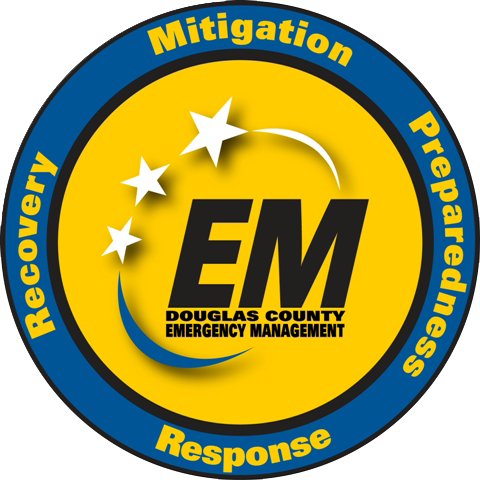Emergency Management
Emergency Preparedness for Businesses and Organizations
Prepare your business or organization for an emergency with these steps.
Why is preparedness important for my business?
Businesses face a wide variety of natural and human-caused hazards which can impact or interrupt your operations. To better ensure the safety of you, your employees, and your customers, it is important to plan for a variety of emergencies. Every business can take steps to lessen the impact of an emergency on their staff, customers, and operations. The following steps are described in detail below.
Step 1: Identify what risks you face.
Douglas County faces a wide variety of possible hazards. Think about how different hazards would impact your business, employees, and customers. The following are all events that could have a significant impact on the operations of your business:
- Natural disasters like floods, fires, tornadoes, and damaging winds.
- Health hazards like widespread sickness and pandemic.
- Human-caused/technological disasters like gas line breaks, accidents, power outages, equipment failure and acts of violence.

Step 2: Develop an emergency plan.
- Notification and Communication
- Identify How to Get Emergency Alerts. Have more than one way to receive emergency alerts. Designate at least one person and one back-up person per location and shift to receive notifications.
- NEKS Regional Notification System
- WEAs (Wireless Emergency Alerts)
- NOAA Weather Radio
- Outdoor Warning Sirens
- Our social media: Facebook or X (Twitter)
- Local radio and TV
- Define the process for notifying all employees and customers.
- Which levels of emergency will trigger notification?
- How will you notify employees and customers? How will you direct them to take action?
- How will you account for employees and customers if you take shelter?
- Designate a Shelter
- Identify a room(s) on the lowest level of the building, in an interior room, with no windows.
- Be sure it can hold your employees and customers.
- Label your shelter(s) with some kind of signage.
- Designate an Evacuation Meeting Location
- If your building must be evacuated, have a location for everyone to meet up.
- Make sure employees know where this location is, and establish a process for accounting for everyone once you arrive.
- Identify a room(s) on the lowest level of the building, in an interior room, with no windows.
- Identify How to Get Emergency Alerts. Have more than one way to receive emergency alerts. Designate at least one person and one back-up person per location and shift to receive notifications.
Step 3: Create a preparedness kit.
You’ve developed a plan for employees and customers to take shelter during an emergency if needed. What needs will these people have once they are sheltering? Collect basic supplies to keep in or near your shelter.
We recommend having some basic supplies in your designated shelter:
- Flashlight(s) w/ extra batteries
- Basic First Aid Kit
- NOAA WX Radio and/or AM/FM Radio
- **List of employees and their contact information in case of an emergency
- **List of guests/patrons if they check in (e.g. hotels)
Step 4: Train, exercise, and revise your emergency plan.
Your plan can only be effective if everyone knows how to put it into action. This will require creating a training and revision schedule that you can stick to.
- Regularly train employees in the details of your emergency plan.
- Exercise your plan. Regularly hold drills or other activities to test the plan.
- Revise the plan on a regular basis based on its success in exercises or real-world incidents.
Step 5: Develop a Continuity of Operations Plan.
Your Emergency Plan is the start of getting your business ready for an emergency - both specific to your business or a community-wide disaster. Next, consider working through a Continuity of Operations Plan (COOP). This plan covers any type of business interruption – fire, flood, tornado, power outage, etc. Here are just a few of the questions that should be considered and put into a COOP.
- What will you do when your business is interrupted - short term or long term?
- What's most important to get up and running?
- Can you operate from another location?
- Are your business files backed up off site or online?
- Have you reviewed your insurance policy and do you understand what it covers?
- What happens if your business is damaged, and you must close to a time?
- How do you notify employees? Will they continue to be paid?
- How will you notify suppliers of this change?
Step 6: Ask for help.
Douglas County Emergency Management staff can assist you and your business in wide variety of ways, including:
- Acquiring and setting up a NOAA weather radio
- Getting employees signed up for emergency notifications
- Personalized Business Support:
- Providing resources and support as you develop an Emergency and/or Continuity of Operations Plans
- Speaking with your employees about severe weather safety
- Connecting you with first responders to complete a walkthrough of your facility
Please reach out to us at emermgmt@dgcoks.gov or 785-832-5259.
